TWO EARLY EIGHTEENTH CENTURY BAROMETERS
May 15th 2013
Britain’s obsession with the weather is something of a national joke – so much so that Burberry-style rain coats and umbrellas are viewed as part of our national dress. We talk about the weather, the tabloid papers even make the weather front-page news, and invariably we ask ourselves each morning, “will it rain today?” But on the other side of the coin we are also a nation that is supremely optimistic about the weather, always ready when the clouds clear and the sun appears – we buy more convertible cars than any country in Europe, and when those sunny days arrive, lily-white English legs are exposed in shorts and sandals, as we bask in the sun in front of every pub and café or lay out the picnic blanket or barbecue in our gardens, the park or at the seaside.
So it shouldn’t be surprising that British craftsmen were renowned from the eighteenth century onwards for the quality of the barometers they produced. Not only did they offer accurate readings on changeable weather conditions, but they were beautifully fashioned objects made of the finest materials.
Two examples, one dating perhaps to 1705, and another of about 1715-1720, illustrate the exquisite style and construction which was typical of the finest English barometers.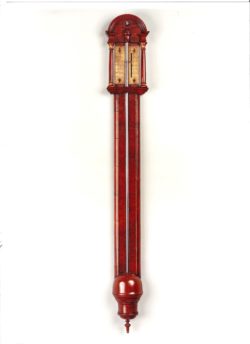
Stick Barometer by John Patrick, London, c. 1705. Raffety Fine Antique Clocks
The earliest, a stick barometer signed by the celebrated maker John Patrick of London (fl. 1685-1722) is constructed of fine walnut veneer on an oak carcass. The top of the barometer reflects classical architecture, with a rounded arch and doric columns framing the elegant brass barometer scale, engraved with a decorative wheat ear border. Patrick had begun his career as an apprentice to the joiner William Thompson, before specialising as a barometer maker. He seems to have initially had a shop ‘against Bull Head Court in Jewin Street, near Cripplegate Church’ [Goodison:197], before moving to Ship Court, Old Bailey in London.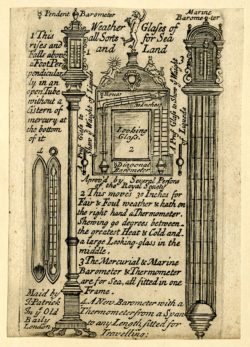
Advertisement for Barometers by John Patrick, c.1705-1715. British Museum, Ilbert Collection. Accession number 1958,1006.3050. Copyright The Trustees of the British Museum
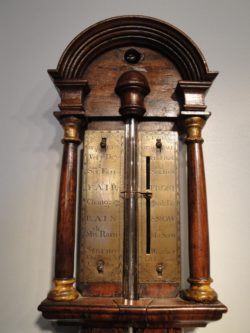
Detail of Register Plate, Stick Barometer by John Patrick, London, c.1705. Raffety Fine Antique Clocks
He was one of the leading barometer makers of his day, supplying barometers to some of the top clock makers in London, including Quare, Marhsall and Graham [Goodison: 197]. Patrick also published articles on the Rules and Observations of barometers and was praised by a contemporary “for the many experiments he hath made in order to improve the Barometer, and which he is always willing to shew to all ingenious and curious persons.” [Banfield: 19]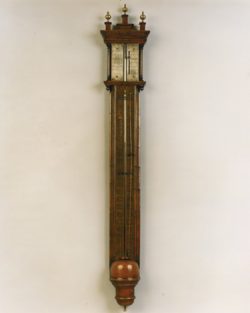
Unsigned George I Walnut Stick Barometer with Royal Society Scales. Raffety Fine Antique Clocks
The second barometer is similar in style to Patrick’s work but is unsigned. Also of walnut, it retains its original engraved register plate, as well as what appears to be the original Royal Society temperature scales on paper, with handwritten notations along the length of the stem. The Royal Society scale was used in the first quarter of the eighteenth century. The top of the barometer has a distinctive architectural feel, with elegant doric columns framing the register plate and the top crowned with a cornice and three pinnacles with brass finials, reminiscent of the architectural motifs of Sir John Vanbrugh and Nicholas Hawksmoor.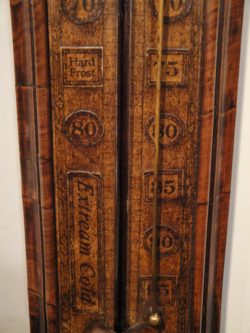
Detail of Royal Society Scales, Unsigned Stick Barometer, c.1715-1720. Raffety Fine Antique Clocks
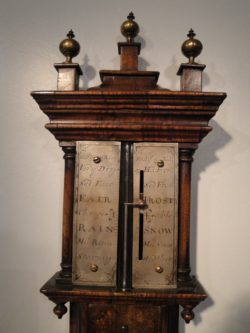
Detail of Silvered Register Plate, Unsigned George I Walnut Stick Barometer,
c.1715-1720. Raffety Fine Antique Clocks
The style of these two barometers, and indeed of most produced during the eighteenth century, would appear to have been directly influenced by the architectural fashions of the day. The aristocratic elite of early eighteenth century Britain were both classically educated and took a distinctive interest in science, so a barometer would most likely have been found in the library of many a country house, along with globes, telescopes and other scientific instruments. This was also a time when classical revival architecture was popular, with men like the Palladian enthusiasts Lord Burlington and his architect/teacher Colen Campbell, the author of Vitruvius Britannicus, leading a revolution in country house architecture and domestic design.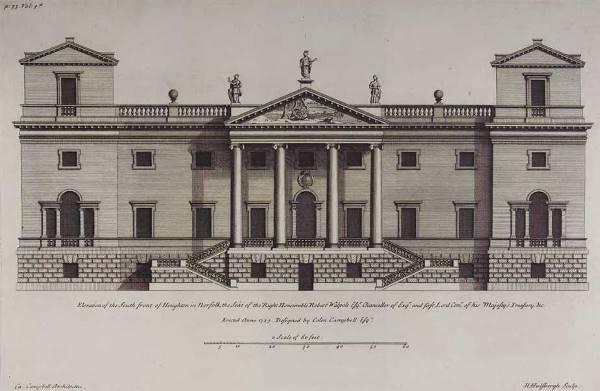 Design for Houghton Hall by Colen Campbell. Published in Vitruvius Britannicus. Photo courtesy Wikipedia
Design for Houghton Hall by Colen Campbell. Published in Vitruvius Britannicus. Photo courtesy Wikipedia
It is easy to imagine these fine barometers gracing the libraries of great country houses like Houghton Hall or Blenheim Palace, a reflection of the erudite interests and tastes of their owners. Some 300 years after they were made, they still provide an accurate reading on the changing weather, and look as good today on the wall of a modern library or study as they once did in the grand interiors of Queen Anne and Georgian period houses for which they were made.
By Tara Draper-Stumm, MA FSA
The two barometers featured above are available for sale at Raffety Fine Antique Clocks
Further Reading:
Goodison, English Barometers 1680-1860 (Woodbridge, 1969)
Banfield, Barometers: Stick or System Tube (Trowbridge, 1985)
So it shouldn’t be surprising that British craftsmen were renowned from the eighteenth century onwards for the quality of the barometers they produced. Not only did they offer accurate readings on changeable weather conditions, but they were beautifully fashioned objects made of the finest materials.
Two examples, one dating perhaps to 1705, and another of about 1715-1720, illustrate the exquisite style and construction which was typical of the finest English barometers.

Stick Barometer by John Patrick, London, c. 1705. Raffety Fine Antique Clocks
The earliest, a stick barometer signed by the celebrated maker John Patrick of London (fl. 1685-1722) is constructed of fine walnut veneer on an oak carcass. The top of the barometer reflects classical architecture, with a rounded arch and doric columns framing the elegant brass barometer scale, engraved with a decorative wheat ear border. Patrick had begun his career as an apprentice to the joiner William Thompson, before specialising as a barometer maker. He seems to have initially had a shop ‘against Bull Head Court in Jewin Street, near Cripplegate Church’ [Goodison:197], before moving to Ship Court, Old Bailey in London.

Advertisement for Barometers by John Patrick, c.1705-1715. British Museum, Ilbert Collection. Accession number 1958,1006.3050. Copyright The Trustees of the British Museum

Detail of Register Plate, Stick Barometer by John Patrick, London, c.1705. Raffety Fine Antique Clocks
He was one of the leading barometer makers of his day, supplying barometers to some of the top clock makers in London, including Quare, Marhsall and Graham [Goodison: 197]. Patrick also published articles on the Rules and Observations of barometers and was praised by a contemporary “for the many experiments he hath made in order to improve the Barometer, and which he is always willing to shew to all ingenious and curious persons.” [Banfield: 19]

Unsigned George I Walnut Stick Barometer with Royal Society Scales. Raffety Fine Antique Clocks
The second barometer is similar in style to Patrick’s work but is unsigned. Also of walnut, it retains its original engraved register plate, as well as what appears to be the original Royal Society temperature scales on paper, with handwritten notations along the length of the stem. The Royal Society scale was used in the first quarter of the eighteenth century. The top of the barometer has a distinctive architectural feel, with elegant doric columns framing the register plate and the top crowned with a cornice and three pinnacles with brass finials, reminiscent of the architectural motifs of Sir John Vanbrugh and Nicholas Hawksmoor.

Detail of Royal Society Scales, Unsigned Stick Barometer, c.1715-1720. Raffety Fine Antique Clocks

Detail of Silvered Register Plate, Unsigned George I Walnut Stick Barometer,
c.1715-1720. Raffety Fine Antique Clocks
The style of these two barometers, and indeed of most produced during the eighteenth century, would appear to have been directly influenced by the architectural fashions of the day. The aristocratic elite of early eighteenth century Britain were both classically educated and took a distinctive interest in science, so a barometer would most likely have been found in the library of many a country house, along with globes, telescopes and other scientific instruments. This was also a time when classical revival architecture was popular, with men like the Palladian enthusiasts Lord Burlington and his architect/teacher Colen Campbell, the author of Vitruvius Britannicus, leading a revolution in country house architecture and domestic design.
 Design for Houghton Hall by Colen Campbell. Published in Vitruvius Britannicus. Photo courtesy Wikipedia
Design for Houghton Hall by Colen Campbell. Published in Vitruvius Britannicus. Photo courtesy WikipediaIt is easy to imagine these fine barometers gracing the libraries of great country houses like Houghton Hall or Blenheim Palace, a reflection of the erudite interests and tastes of their owners. Some 300 years after they were made, they still provide an accurate reading on the changing weather, and look as good today on the wall of a modern library or study as they once did in the grand interiors of Queen Anne and Georgian period houses for which they were made.
By Tara Draper-Stumm, MA FSA
The two barometers featured above are available for sale at Raffety Fine Antique Clocks
Further Reading:
Goodison, English Barometers 1680-1860 (Woodbridge, 1969)
Banfield, Barometers: Stick or System Tube (Trowbridge, 1985)

